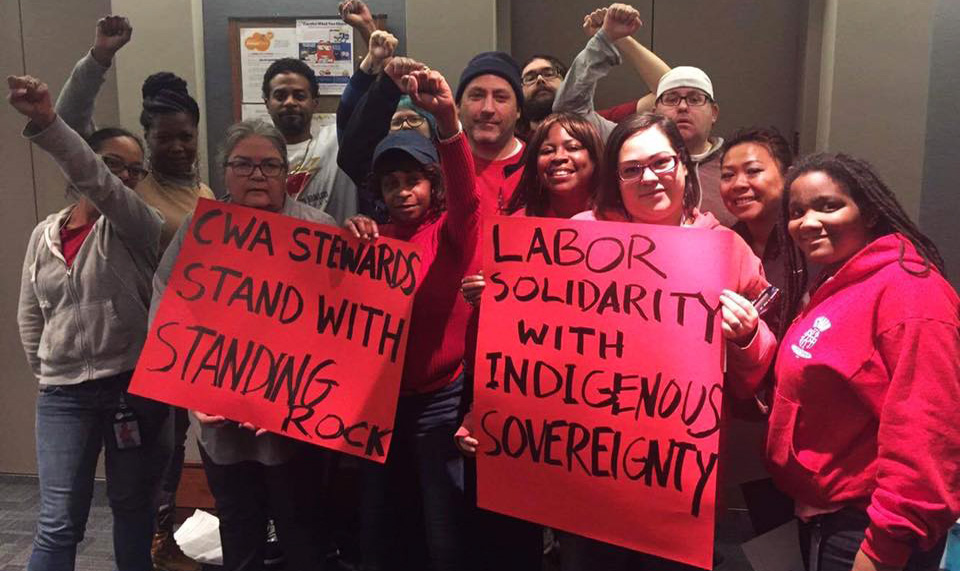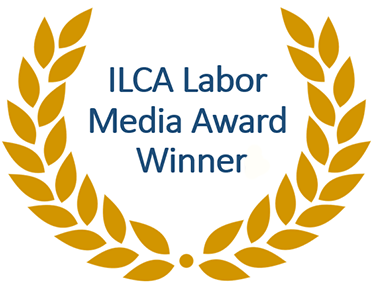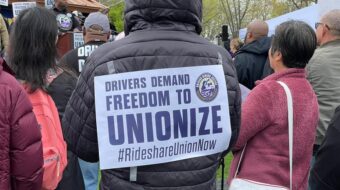

ILCA, Third Place, Best Analysis
Jobs or the environment? For labor, that seems to be the perennial dilemma.
“For some people it is jobs at all costs, but you don’t employ people to do damage. You just can’t turn the entire planet into a garbage dump,” said Kevin Cummings, president and founder of Council FIRE (First Inhabitants Rights and Equality), a pro-union group that focuses on Native workers and issues, in a phone interview.
Cummings, who is Lumbee and also a Grand Lodge Representative for the Machinists union (IAMAW), was talking about a dispute over the Dakota Access Pipeline (DAPL) – but not the one that exists between the company and the Native tribes. It’s between building trades unions, whose members would benefit from the good-paying jobs, and other unions and labor groups that support the Standing Rock Sioux tribe and their fight to protect the water, their sovereignty and heritage.
Ever since the rise of the modern-day U.S. environmental movement in the 1970s (remember the spotted owl vs. the timber industry?), corporate interests have been especially adept at framing these issues as jobs vs. the environment, and this oil pipeline is no exception.
“I want those families to have those good jobs. But should jobs trump every other concern? I struggle with that and the House of Labor does too,” Cummings said.
Clean water and sovereignty at stake
Cummings said two principled issues are at stake in North Dakota. One: the fact that the tribal government’s sovereignty was never recognized in the pipeline’s planning process, and two: safe drinking water.
“The pipeline was originally supposed to go across [the Missouri River] near Bismarck, but they moved it because they were worried about Bismarck’s drinking water,” Cummings noted. The company in charge of the project, Energy Transfer Partners, rejected that route citing higher costs and other factors, including how close the pipeline was to Bismarck’s water supply, according to public documents. Since 2010, there have been at least 3,300 oil and gas pipeline breaks in the United States. Other estimates put the number much higher; one study found that in 2013 alone, there were 7,662 spills, blowouts and leaks across 15 states, which is an average of 20 per day.
Such breaks were an almost daily occurrence between Sept. 4-10, 2016, there were four spills in four states with the worst occurring in Alabama, spilling 336,000 gallons of gasoline.
Moreover, Cummings said, based on the Fort Laramie treaties signed in 1851 and 1868 between the federal government and the Sioux Nations, there should have been federal government to tribal government consultation on the project, not sending a low-level county official to consult as an afterthought.
“It’s an insult. Tribes aren’t asking for something not promised,” he said.
Power of Big Oil
But in North Dakota, the oil and gas industry holds sway. The state government has displayed a hostile attitude toward the tribe and all Indian people. In a New York Times article titled, “Taking a stand at Standing Rock,” Standing Rock Sioux chairman David Archambault II wrote, “Perhaps only in North Dakota, where oil tycoons wine and dine elected officials, and where the governor, Jack Dalrymple, serves as an adviser to the Trump campaign, would state and county governments act as the armed enforcement for corporate interests.”
Archambault went on to write about the all too “familiar story in Indian Country” of encroachment by outside interests on tribal lands: “This is the third time that the Sioux Nation’s lands and resources have been taken without regard for tribal interests. The Sioux peoples signed treaties in 1851 and 1868. The government broke them before the ink was dry.”
Protests grow, labor differs
Despite state and local law enforcement using military-like equipment on the reservation and surrounding area as a show of force designed to intimidate and discourage protesters, racial profiling of Native people, and private security guards using dogs and tear gas on protesters, the encampment at Standing Rock has only grown. The tribe has also protested through the court system and their suit seeking an injunction is currently on appeal.
Meanwhile, construction on the pipeline has continued although the Obama administration stepped in on Sept 9 and halted construction on land belonging to the Army Corps of Engineers until the matter can be reviewed. The administration also called on the company to voluntarily pause construction on non-Corps land that the tribe considers sacred.
It was in this context that unions and labor groups issued statements in support of and against the protests. The AFL-CIO, in a brief, carefully-worded statement on Sept. 15, called on the Obama administration to allow the project to continue. While acknowledging climate change and Native rights the federation said it supports pipelines construction and it was “fundamentally unfair to hold union members’ livelihoods and their families’ financial security hostage to endless delay.”
Some 3,500-4,500 jobs at good union wages are said to be at stake for building trades unions like the Laborers (LiUNA). That union issued a statement on Sept. 6, saying it found confrontational protests on construction sites “deeply troubling,” and people just “trying to do their job … face[ed] intimidation” by “extremists,” after protesters disrupted bulldozing on a site that the tribe identified as a burial and cultural area. But as Cummings and other observers note, these jobs end upon completion of the pipeline, lasting a couple of years at most, “while the damage could last for eternity.”
Immediately following the AFL-CIO statement, a coalition of AFL-CIO constituency groups issued a statement on Sept. 19 in support of the protesters. Constituency groups serve as a way for labor as a whole to connect to Black, Latino, Asian-Pacific Island, women and LGBT union members, workers and communities, and address issues that arise from their specific struggles and experiences.
Individual unions that support the halt on construction until the tribe’s concerns are addressed include the Service Employee International Union, Communications Workers of America and National Nurses United.
The most obvious group missing is Native workers. For the last 10 years, since the founding of Council FIRE, Cummings has been trying to change that and said next year at the AFL-CIO convention he expects there will be formal recognition of Council FIRE as a constituency group by the federation.
Part of growth
Cummings sees the disagreements in the House of Labor as potentially healthy development. “A large portion of our members care about the planet,” he says. “Labor is growing up from that mindset of paycheck only. We can’t argue the same practice as we did in the 1960s. Members are calling for us to be more eco-friendly.”
Cummings finds it encouraging and a sign of maturity that there can be dialogue within the labor movement “instead of lockstep” with only one viewpoint.
“I think it’s part of growing,” he said. “We have the same mixed feelings about green jobs,” Cummings said, referring to his own union. He cited the Steelworkers as being in the forefront in the last 20 years of building a blue collar-green collar alliance. But the number of green jobs and the wages in that sector are not at the level needed even though it is in that forward-thinking direction that the labor movement has to go, Cummings said.
Common cause
Many labor activists were dismayed by the position taken by the AFL-CIO and building trades unions. But some, like J. Mijin Cha, a professor of urban and environmental policy at Occidental College, looked to find common cause between labor and climate advocates, rejecting vilification of the AFL-CIO. Writing in the Huffington Post, Cha said, Standing Rock activists and the AFL-CIO “have a common enemy: the fossil fuel industry, which puts profits over workers and is the worst contributor to climate change.”
Similarly, Cummings said that unions shouldn’t “carry water for the company” because labor and tribes have more in common than not. He noted that building trades have often reached out to tribes for apprenticeship programs. “Unions are not the enemy,” he said. “Labor is stepping into new frontiers never seen before.”
When Cummings goes to speak to Native groups, he said, he always finds union members there: “Tribal leaders pull out their union cards. A lot of Native workers are in the building trades. They’ll say, ‘I’m a pipefitter. I’m with SEIU, or UFCW, or Machinists or Miners.’”
With suicide rates among Native youth at several times higher than the national average and young Alaskan Native women commit suicide at nineteen times the national average, rampant health problems like diabetes, obstacles to accessing clean water, and up to 90 percent unemployment on reservations, tribes want jobs and development, but done in a sustainable, environmentally and culturally aware way, Cummings said.
Labor also recognizes one inescapable reality: “There is no planet B,” he said.












Comments